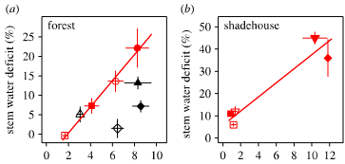The Science
The amount of water that tropical trees lost from their stems during drought conditions, when trees lack access to soil water, was correlated with their bark water vapor conductance, i.e., the leakiness of bark to water vapor. This suggests that water loss through bark may be an important and overlooked mechanism that influences stem dehydration and drought performance.
The Impact
Predicting drought performance among trees is a major challenge. These results suggest that incorporating the rate of water loss from bark can help to predict the rate at which trees dehydrate and die during droughts.
Summary
Saplings of several tree species in Panama were measured for stem water content during well-watered conditions and drought conditions in forest understories and in a shadehouse experiment to assess stem water deficit during drought. Saplings of the same species were collected and measured for bark water vapor conductance. In both datasets, bark water vapor conductance was correlated with stem water deficit among species that lacked assess to soil water.

Contacts (BER PM): Daniel Stover, SC-23.1, Daniel.Stover@science.doe.gov (301-903-0289)
PI Contact: Brett Wolfe, School of Renewable Natural Resources, Louisiana State University Agricultural Center, Baton Rouge, LA, Wolfe1@lsu.edu
Funding
This project was supported by the Next Generation Ecosystem Experiments-Tropics and by the US Department of Energy, Office of Science, Office of Biological and Environmental Research.
Publications
Wolfe BT. 2020 Bark water vapour conductance is associated with drought performance in tropical trees. Biol. Lett. 16: 20200263. http://dx.doi.org/10.1098/rsbl.2020.0263